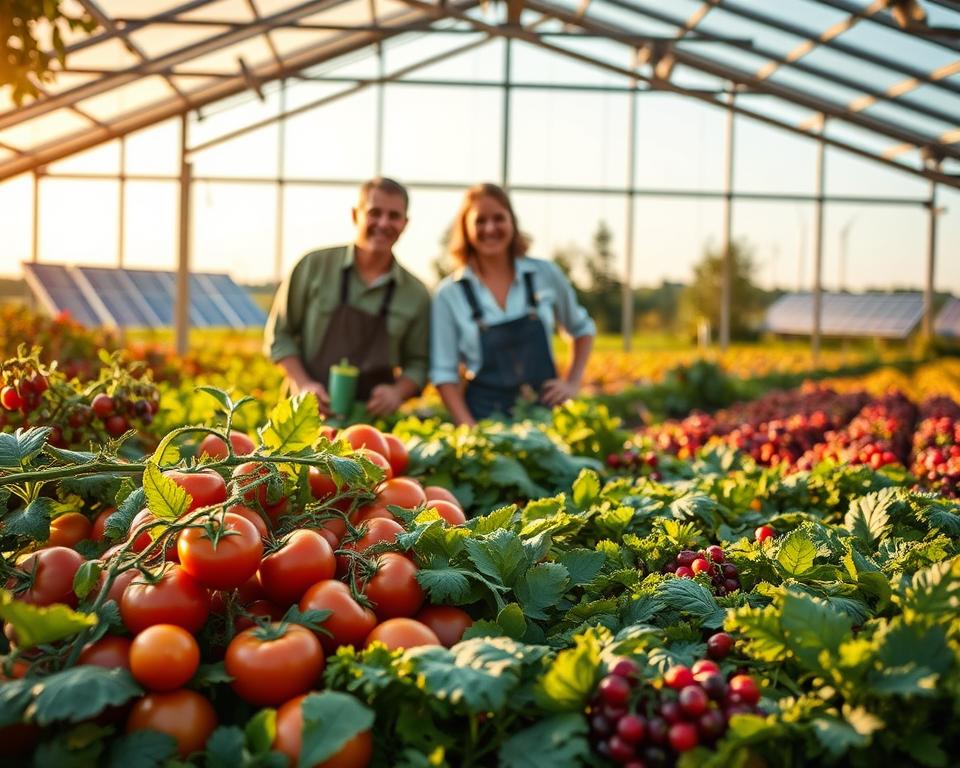Анунсиос
Foodtech trends 2025 lays out clear numbers, real case studies, and practical next steps you can use in your roadmap now.
Global pressure is urgent: the FAO estimates food production must rise about 70% by 2050 to feed nearly 9.1 billion people. Leading manufacturers are already investing in smart automation, data analytics, and cleaner labels to raise output and cut waste.
You’ll see how examples like Chef Robotics at Amy’s Kitchen and packaging moves from FreshPoint, Coca-Cola, and Nestlé drive measurable gains. Data tools can lift efficiency by 10–20%, and sustainability upgrades often pay back with 15–25% cost savings within years.
Can your team turn these numbers into a practical plan that improves product quality, speed, and profit? This report gives the facts and the actions to help you answer that with confidence.
Introduction: why Foodtech trends 2025 matters to your strategy now
Rising demand and new technologies are reshaping how food gets made and delivered. This shift affects production capacity, sustainability goals, and the tools manufacturers use to compete. Early adoption gives you a first-mover advantage and helps avoid costly missteps as consumer expectations evolve.
Анунсиос
Context and relevance
The industry is entering an era defined by automation, cleaner labels, and data-driven decisions. FAO projections show nearly 9.1 billion people by 2050, driving a large rise in required food output. Companies investing in AI, alternative proteins, and climate tech are proving that practical innovation creates measurable value.
What you’ll learn in this report
You’ll get clear metrics, real case studies, and actionable steps to align products, ingredients, and systems with market demand. Expect concise guidance on packaging, production upgrades, and consumer-facing choices that lift value without long delays.
How we sourced and validated the insights
We draw on FAO data, Innova signals, and recent partnerships like ICL‑Protera and ICL‑Plantible. Facts and figures come from recognized research and are reviewed periodically to keep pace with changes in food safety and climate change. This report does not provide medical advice; health topics reflect consumer interest and labeling trends.
Анунсиос
- Practical focus: prioritize moves that deliver results within months.
- Verified sources: industry research and documented manufacturer examples.
- Clear outcomes: roadmap steps you can test, measure, and scale.
Key metrics shaping the 2025 landscape
Concrete metrics now shape how you plan capacity and risk in the global food system. Use these benchmarks to build quarterly scorecards and assign owners who can act fast.
Demand and capacity: population growth and production pressure
FAO projects nearly 9.1 billion people by 2050, which implies about a 70% rise in food production need. Anchor your demand planning to that macro signal so you can phase capacity upgrades without overspending.
Operational performance: efficiency, waste, and uptime benchmarks
Data analytics programs typically deliver 10–20% efficiency gains. Sustainability projects yield 15–25% operating savings on energy, water, and waste within a few years.
Connect systems from batching to packaging to cut micro-stoppages, raise OEE, and lower contamination risk. Turn these figures into measurable KPIs you review each quarter.
Investment signals: where capital and partnerships are flowing
Investments cluster in AI, precision fermentation, and alternative protein work. Notable collaborations include ICL with Protera and ICL with Plantible.
- Track where funding moves to spot early market signals.
- Use ingredient cost indices to time buys and hedge exposure.
- Build risk dashboards that include climate change stress on supply chains.
Foodtech trends 2025: consumer demand signals you can act on
Consumers are signaling clear preferences that reshape product roadmaps and shelf decisions. Use Innova’s insights to turn those cues into fast, testable moves that boost value and shelf appeal.
Ingredients and quality: value beyond price
Innova shows 61% of shoppers notice store‑brand quality. Tell a clear sourcing story, name recognizable ingredients, and call out simple processes to win value-driven buyers.
Personalization and precision wellness without medical claims
People want products that match life stage and lifestyle. Use on-pack language and format choices to signal precision and relevance—avoid medical claims and stick to preference-based wording.
Plant-based reimagined: simpler labels and better taste
Simplify recipes and highlight familiar proteins like fava bean or lentil to improve taste and functionality. Tighten labels so consumers see value at a glance.
Tradition reinvented and wildly inventive flavors
Limited editions are growing ~16% a year, while 43% of consumers seek unique creations. Test seasonal flavors with small runs and protect core SKUs to manage supply and margin risk.
- Action: Pair clear ingredient stories with shelf-friendly packaging cues.
- Action: Pilot taste-first reformulations with suppliers to scale quickly.
- Action: Use social listening to refine or retire inventive products early.
Automation and intelligent factories: scaling resilient food production
Robots and data are helping plants hit higher throughput with fewer manual touches. Start with a narrow pilot to prove value and limit disruption.
Robotics and cobots: from delicate handling to heavy palletizing
Vision-enabled robots now handle fragile baked goods and heavy palletizing on the same floor. Use cobots for short runs and fast changeovers so your team focuses on oversight and safety checks.
Case in point: Chef Robotics and adaptive assembly lines
Chef Robotics trained arms on real production data at Amy’s Kitchen and improved consistency, cut waste, and raised labor productivity without large reprogramming projects. That practical approach shortens ramp time.
Predictive maintenance and OEE improvements with data
Connect batching, forming, and palletizing systems to reduce touches and contamination risk. Then stand up predictive maintenance tied to OEE to track micro-stoppages and MTBF.
Action plan: pilot, measure, and redeploy labor to higher-value roles
- Pilot on one SKU family with vision-based portioning; measure yield, defect rate, and cycle time weekly.
- Build a business case around safety, uptime, and unit cost so stakeholders see quick wins.
- Retrain staff into quality, sanitation, and line optimization roles to support health and career growth.
Data, AI, and digital transformation across the supply chain
When sensors feed clean data, your team can stop guessing and start preventing losses across perishable flows.
From sensors to decisions: real-time analytics for perishable flows
Instrument cold and ambient zones with temperature, humidity, and pressure sensors. Feed that data into dashboards so operators act on deviations before they affect quality.
Remote oversight: secure access, IoT, and AR-enabled support
Use role-based access and secure tunneling so remote experts can support plants without exposing core systems. Log every session for audit and training.
AI in product design, safety monitoring, and demand planning
Apply AI to formulation screening and shelf-life models to narrow lab trials. Then validate on the line to protect consistency and health standards.
Roadmap: cloud ERP, connected quality, and cross-functional skills
Start with cloud ERP and connected quality modules. Add planning and maintenance tools as your team gains skills. Define data roles across production, quality, and maintenance so accountability is clear.
- Combine line data with inventory and weather to fine-tune schedules for perishable production.
- Automate hazard monitoring and escalate to humans for investigation to reinforce food safety.
- Review progress quarterly and tie investments to measured improvements in throughput, complaints, and service levels.
Sustainability and climate adaptation: cutting impact while creating value
Small system fixes can deliver outsized savings while improving supply chain resilience. Focus on practical steps that cut operating costs and shore up supply for the food items you make.

Energy, water, and waste: where 15–25% savings emerge
Target quick wins: compressed air fixes, heat recovery, and VFDs stack to reduce energy use. Plants that add efficient motors and recover heat report 15–25% operating savings within a few years.
Recycle and recirculate process water where feasible. Add meters so you quantify savings and confirm compliance.
Climate-resilient sourcing
Track exposure to stressed crops such as cocoa and coffee. Prequalify substitutes that match function and labeling so production stays steady as inputs shift.
Reformulate with resilient ingredients and processing aids to protect texture and shelf life without compromising quality.
Circularity and packaging that reduce food waste
Choose packaging that balances recyclability, barrier properties, and line efficiency. Validate that it supports traceability and clear consumer cues.
- Capture hotspots: run mass-balance audits to find food waste and fix portioning or trimming.
- Engage suppliers: align incentives across supply chains to recover value and cut loss.
- Measure claims: communicate progress with transparent data—avoid overpromising.
Keep your roadmap flexible and update it annually as climate impacts evolve and reporting standards rise. These operational moves protect value, improve compliance, and lower your environmental impact while serving consumers and future production needs.
Alternative proteins and precision fermentation: from pilots to scale
What works in a lab often needs retooling on the line; that friction defines the next phase for alternative proteins. You must align formulation, processing, and supplier readiness before larger production runs.
Processing realities: texture, moisture, shelf life, and allergen controls
Design for texture and moisture early. Pilot runs should test binders, shear, and thermal steps that shape bite and shelf life.
Treat allergen and cross-contact risks seriously when animal and non‑animal lines share space. Use cleaning validation and traffic flows or choose dedicated facilities.
Precision fermentation spotlight: Protera’s AI-designed proteins
Protera uses MADI, an AI platform, to design functional protein ingredients that speed discovery and improve processing performance for manufacturers.
Carbon utilization: Arkeon’s CO₂-to-amino acid pathway
Arkeon converts CO₂ into essential amino acids with microbes, offering a land‑light route to ingredients that can diversify supply and support sustainability goals.
Action plan: flexible lines, supplier vetting, and hybrid products
- Build modular systems so you can swap extruders, fermenters, or dryers as formulations evolve.
- Vet suppliers for consistency, regulatory readiness, and documentation to smooth scale-up and audits.
- Consider hybrids that mix plant, fermentation-derived, or small meat fractions to balance cost and consumer acceptance.
Cultivated meat: opportunity, constraints, and go-to-market steps
New cell‑based options draw interest, yet practical limits shape how you can participate today. There are real opportunities) to learn and test without full-scale bets.
Cost, regulatory pathways, and consumer expectations
Recognize core challenges: bioreactor costs, media expenses, and long regulatory timelines set your pace. Focus tests on taste, texture, appearance, and aroma—these drive consumer acceptance more than abstract claims.
Near-term plays: blends, ingredients, and B2B collaborations
Start with blends that add small cultivated shares to plant bases to hit price points and scale production responsibly. Supply B2B ingredients for flavor or texture so you engage the market while you learn regulatory and quality demands.
- Partner with manufacturers and systems integrators to handle validation and food safety documentation.
- Align claims with rules; avoid health promises and emphasize culinary experience.
- Sequence your rollout: pilot, limited channel launch, then scale when costs and feedback align.
Keep a market watchlist for approvals and sentiment so you can adjust your roadmap as the industry and future standards evolve.
Smart packaging and traceability: extending shelf life and trust
Smart packaging turns simple cartons into active data sources that protect quality and cut loss.
Use freshness sensors, TTIs, QR codes, and NFC tags so your product can report temperature, origin, and handling. FreshPoint’s time‑temperature indicators and Coca‑Cola and Nestlé’s QR/AR moves show how traceability reduces waste and builds trust.
Upgrade lines and add in‑line checks so sensor reads feed your systems for full-batch traceability. Pair active materials that absorb oxygen or moisture with validation in real logistics to extend shelf life and lower returns.
Начните с малого: pilot one line and one SKU, tie packaging data to food safety and dashboards, then scale as results and customer scans prove ROI. You’ve got this—act now and lock in clearer value for your customers and the environment.



